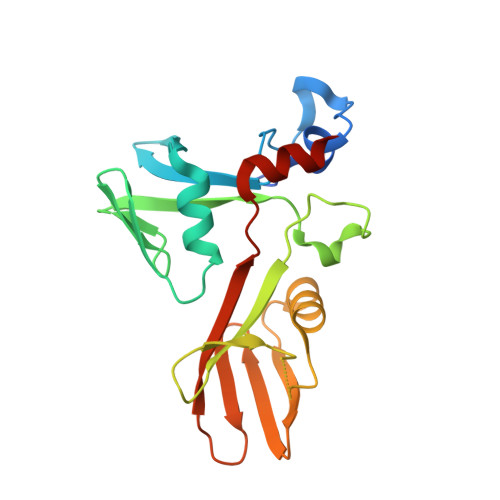Poly(ADP-ribose) potentiates ZAP antiviral activity.
Xue, G., Braczyk, K., Goncalves-Carneiro, D., Dawidziak, D.M., Sanchez, K., Ong, H., Wan, Y., Zadrozny, K.K., Ganser-Pornillos, B.K., Bieniasz, P.D., Pornillos, O.(2022) PLoS Pathog 18: e1009202-e1009202
- PubMed: 35130321
- DOI: https://doi.org/10.1371/journal.ppat.1009202
- Primary Citation of Related Structures:
7KZH, 7TGQ - PubMed Abstract:
Zinc-finger antiviral protein (ZAP), also known as poly(ADP-ribose) polymerase 13 (PARP13), is an antiviral factor that selectively targets viral RNA for degradation. ZAP is active against both DNA and RNA viruses, including important human pathogens such as hepatitis B virus and type 1 human immunodeficiency virus (HIV-1). ZAP selectively binds CpG dinucleotides through its N-terminal RNA-binding domain, which consists of four zinc fingers. ZAP also contains a central region that consists of a fifth zinc finger and two WWE domains. Through structural and biochemical studies, we found that the fifth zinc finger and tandem WWEs of ZAP combine into a single integrated domain that binds to poly(ADP-ribose) (PAR), a cellular polynucleotide. PAR binding is mediated by the second WWE module of ZAP and likely involves specific recognition of an adenosine diphosphate-containing unit of PAR. Mutation of the PAR binding site in ZAP abrogates the interaction in vitro and diminishes ZAP activity against a CpG-rich HIV-1 reporter virus and murine leukemia virus. In cells, PAR facilitates formation of non-membranous sub-cellular compartments such as DNA repair foci, spindle poles and cytosolic RNA stress granules. Our results suggest that ZAP-mediated viral mRNA degradation is facilitated by PAR, and provides a biophysical rationale for the reported association of ZAP with RNA stress granules.
- Department of Molecular Physiology and Biological Physics, University of Virginia, Charlottesville, Virginia, United States of America.
Organizational Affiliation:



















